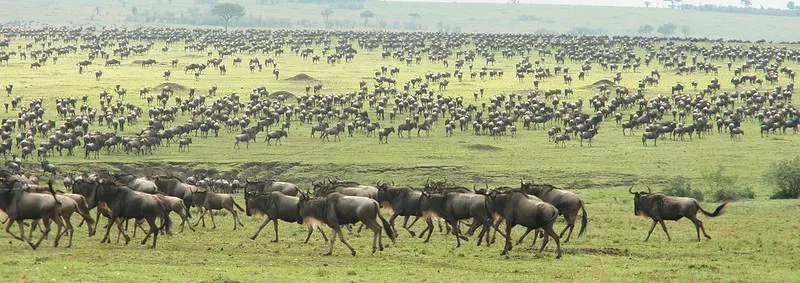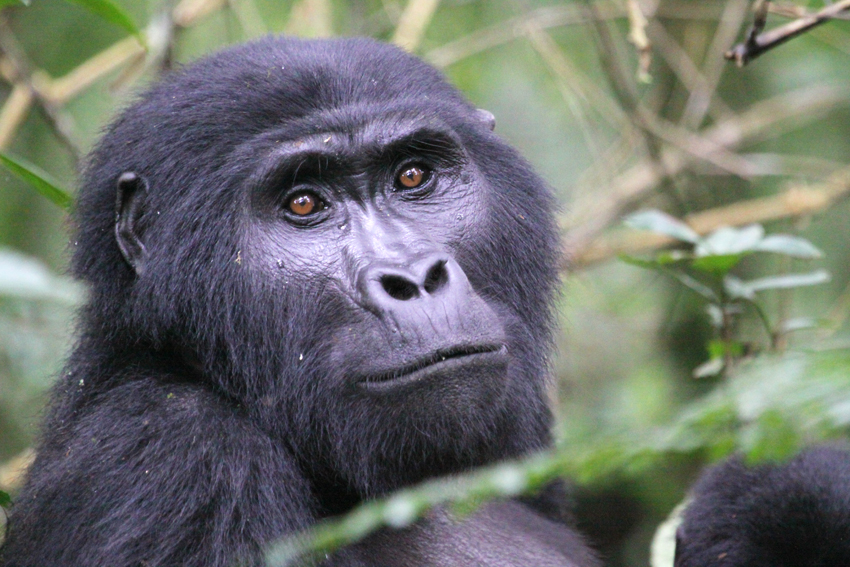Annual Patterns Of Wildebeest Migration In East Africa
Patterns Of Wildebeest Migration. Due to several uncontrollable natural variables, the Great Wildebeest migratory patterns in East Africa are constantly changing. The rain pattern, which is difficult to forecast each year, is the most notable element that precedes the major migration. It is only conjecture as to when the rainy season in this region will begin or conclude.
Tanzania (Serengeti National Park) and Kenya (Masai Mara National Reserve) are two East African nations that take pride in the big wildebeest migration.
It is unknown when the wildebeests are thought to begin their voyage, but people who are interested in the massive migration of wildebeests take into account the current signals.
The greatest time to see the massive wildebeest migration from Southern Serengeti National Park is said to be during the dry season, which runs from June to September in this region. In the direction of the Northern Serengeti, the herd of herbivores, which includes gazelles, zebras, and impalas, looks for fresh grazing sites.
The increasing population during the January–March calving period is what started this trend. Grass becomes sparse in the later stages due to the increase in wildebeest and other ungulate populations. It is necessary to move, and zebras often initiate this.
When Does the Great Migration of Wildebeests Begin?
Although there is no set schedule for the East African great wildebeest migration, there have been rumors over the years; however, occasionally, they haven’t been confirmed.
It’s Calving Time at Serengeti National Park from January to March.
It is necessary to replenish the crowd with new calves since the angulates lose a lot of members as they travel for various reasons. The majority are born in the Masai Mara National Reserve, where the wildebeest go from August to October, the latter part of the year, before heading back to the Serengeti National Park in November or December.
The calving season is in full swing from January to March, particularly in Tanzania’s Ndutu area. New feeding sites are required when over a million wildebeest join the herd, placing strain on the scarce grass. This area’s pastures are revitalized by the prolonged drought and heavy rainfall. The still-stumbling calves can typically find hiding places away from predators and an abundance of grass to eat.
While in Serengeti National Park, from April to mid-June
Food shortage starts in Tanzania’s Southern Serengeti National Park because of the large number of new herbivore species. The zebras’ movements are often what cause other animals, like as the wildebeest, to start migrating north. Because the calves have not yet grasped the method and their limbs are still weak, their pace is a little slower.
As wildebeest stop over in the Seronera area of central Serengeti National Park, the rains are currently beginning to lessen, and the dry season is gradually beginning to arrive.
This is regarded as the shoulder season in Tanzania’s tourist calendar. You can take advantage of this chance if you want to stay away from crowds. You may try asking them during this period whether they wish to use upscale amenities like a lodge, but are on a limited budget. Since there are no guests, there is a good chance that you may receive a lower rate for your lodging.
The caravan moves on for the herbivores in small herds at first, then in larger numbers later when the grass in this area becomes limited.
The Great Wildebeest Migration season in Serengeti National Park runs from mid-June to July.
The Serengeti National Park’s west corridor is predicted to have the largest concentration of zebras, gazelles, wildebeests, kobs, and other ungulates. They graze on the grassland beside the Grumeti River here. The youthful
Here, skimmers like lions, hyenas, cheetahs, jackals, Nile crocodiles, and other ravenous predators knock out the weak and exhausted, demonstrating the circle of life. As predators snap their prey, the water instantly becomes crimson.
The Great Wildebeest Migration Season in Serengeti National Park runs from August to September.
The Masai Mara National Reserve in Kenya and the northern portion of Tanzania’s Serengeti National Park are expected to be home to wildebeest and other ungulates by this time. One of the joys of each safari in Africa is this. Due to the large number of tourists during this time of year, there is a crowd on both sides. It is the pinnacle of tourism in the Masai Mara National Reserve and the Serengeti National Park.
Numerous wildlife media organizations set up their cameras and cameras to record special moments of this massive wildebeest migration. As the wildebeest attempt to battle their way out of the Mara River, which is a life-or-death situation, many beautiful moments occur.
Typically, there is little to no rain during this bright time of year. Typically, the mornings and late evenings are quite chilly.
The Great Wildebeest Migration season runs from October to November.
The final group of wildebeest may migrate into Kenya’s Masai Mara National Reserve from Northern Serengeti National Park this season. Tanzania temporarily loses control of the wildebeest since the majority of these ungulates choose to live on the Masai Mara’s then-luxurious vegetation.
Visitors who are fortunate enough to come here in these final months could spot a few bewildered wildebeest making their way back or eager predators pursuing their meal.
The Masai Mara is now the greatest place to see game in this region because of the abundance of zebras, wildebeest, gazelles, antelopes, and other animals that shade the vast plains.
The Masai Mara’s Great Wildebeest Migration Season, November–December | Patterns Of Wildebeest Migration
As the wildebeest begin their journey back to the Northern Serengeti National Park, the Masai Mara National Reserve in Kenya is the focal point of drama this season. These herbivores begin the calving season by crossing the Mara River slowly but gradually, since there is plenty of food available after their departure.
If you missed the previous season in Serengeti National Park, it is ideal to witness the huge wildebeest migration at Masai Mara National Reserve. If you want to experience a lot of wild animal action over this Christmas season, the Masai Mara National Reserve should be your destination in East Africa.
All other things being equal, the calving season in Serengeti National Park typically lasts from January to March. As soon as the calves are born, even the predators are prepared to seize them while they are still wobbling. This is life’s loop. During the birthing season, there is a greater chance of having a close call with the cannivores. As they attempt to protect their defenseless offspring from snatchers, they may even act in a frenzied herbivorous manner.
Why Reserve a Safari in East Africa During the Great Wildebeest Migration | Patterns Of Wildebeest Migration
In Serengeti National Park during the Calving season
The grass that nourishes the enormous herds of animals is renewed by the frequent rains that coat the area in green. This makes for stunning landscapes for wildlife photography.
Watch as calves come to life, many of them struggling to move around. The newborns are often shielded inside the herds as they migrate since their legs are not yet strong enough to support them.
The calving season is especially noticeable among wildebeests in February, and their sluggish movement makes the enormous congregations of these animals more noticeable. During this period, their next move is more predictable.
Because this is East Africa’s shoulder travel season, there is a good probability that services like lodging, domestic travel, driver guide fees, and others will be offered at a discount. On a low-cost safari package, you can have the chance to stay at a posh hotel in the park.
Even the parks are less congested with visitors’ cars, which might be problematic if you want to get good pictures of wildlife.
During the shoulder season, avid birdwatchers might take advantage of the chance to visit the Masai Mara National Reserve or the Serengeti National Park. More than 500 bird species, including foreign migratory species, may be found in Tanzania’s Serengeti National Park, while Kenya’s Masai Mara National Reserve is home to over 470 bird species, including 57 raptors.
In East Africa, during the Great Wildebeest Migration | Patterns Of Wildebeest Migration
When the wildebeest migration is at its height during the peak season, stunning and distinctive photos and videos can be taken for production stations. To capture their greatest food, even raptors are at their most active during the annual wildebeest migration. The ideal time to see wildlife drama is during this massive migration.
You could have the opportunity to record unique events, such as the prey protecting itself from the predator’s jaws or the predator being overwhelmed by the horde of prey. It is indeed a unique event to see.
In East Africa, during the off-peak safari season | Patterns of Wildebeest Migration
In East Africa, February through May is often the low season for safaris, but even though the great migration may not be at its peak, there are still plenty of benefits to be had at this time.
On a broad plain, the vegetation is dense with greenery. This is the ideal time to visit the Masai Mara National Reserve or the Serengeti National Park if you’re looking for a stunning backdrop for your photos.
Crowds of cars that congregate in the Masai Mara National Reserve or the Serengeti National Park do less damage. Even though there might not be many animals, you can video or take sharper pictures of those that are there without any obstacles.
Low-season rates are reasonable for lodges and other service providers, and even upscale amenities could be within budget during this time. During the off-season, many parks have little to no traffic, which puts a halt to commerce.
What to Bring: Safari Clothes for the Great Wildebeest Migration in East Africa | Patterns of Wildebeest Migration
It’s a wonderful idea to pack long convertible pants or a shirt for a safari. When the weather gets hot during a game drive, you can crank up or change these clothes into shorts.
Apply sunscreen all over your body to protect it from the sun’s rays, especially if you plan to swim and lounge by the pool.
Wearing sunglasses while driving through a park will shield your eyes from the glaring light.
Foldable Safari hat
should wear it when going on a game drive since the paths are dusty and there are buzzing insects in the environment that might unintentionally get into your hair.
In the woods, use insect repellent to ward off stinging insects. In case there are bugs at your resort, bring insect repellent as well.
Safari boots with flip-flops
If you need to step out of the car at any point, have safari boots to wear while on a game drive and flip-flops to change into when you’re relaxing. Because there are many cunning wild creatures in the forest, you should never leave your safari vehicle without a ranger guide accompanying you.
A torch is necessary to track objects in the dark because the lodge’s solar power occasionally goes out.
Some hard currency that you may exchange for local money in case you need to buy souvenirs or other local goods. Although it is not required, you may additionally tip with some of the hard currency as a way to show your gratitude and support your safari service provider staff.
A collapsible water bottle is very useful for adding drinking water to quench your thirst.
Pack your items in a duffel bag to reduce the number of bags you carry, which can occasionally be difficult to track down. Even transporting them might be challenging if you need to switch between facilities.
A camera to record those amazing moments in the woods. For the animals, these are not staged occurrences that occur frequently. The dominant behaviors in the wild determine how distinctive your photographs are.
A set of binoculars with excellent lenses to see animals and other stunning park attractions up close.
Just in case the toiletries at your lodge don’t suit your skin type,
It gets extremely chilly in these parks at night and in the early morning; therefore, it’s best to wear pajamas.
For further information, get in touch with us.
Booking gorilla trekking safaris in Uganda with Katland Safaris after the Wildebeest Migration trip.
Katland Safaris organizes the best gorilla and wildlife safaris in East Africa. When it comes to gorilla trekking, we will book your gorilla trekking permits for Uganda`s Bwindi and Mgahinga gorilla national park and gorilla permits for Volcanoes National Park in Rwanda. Besides booking your gorilla permit, we will also put all other gorilla safari accessories, like transportation and accommodation, in one package to make your gorilla trekking safari a memorable adventure.
Your gorilla trekking safaris can be customized to meet your safari expectations and needs, and budget. The safari package can range from budget, mid-range, and luxury safaris. Feel free to contact our team of excellent safari consultants to help you organize the best Africa gorilla safari ever.


